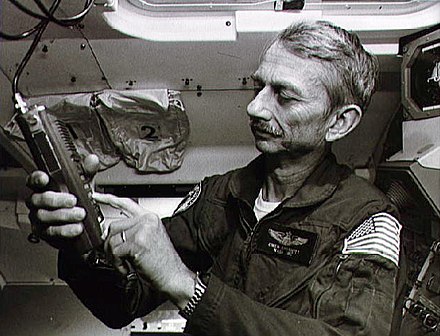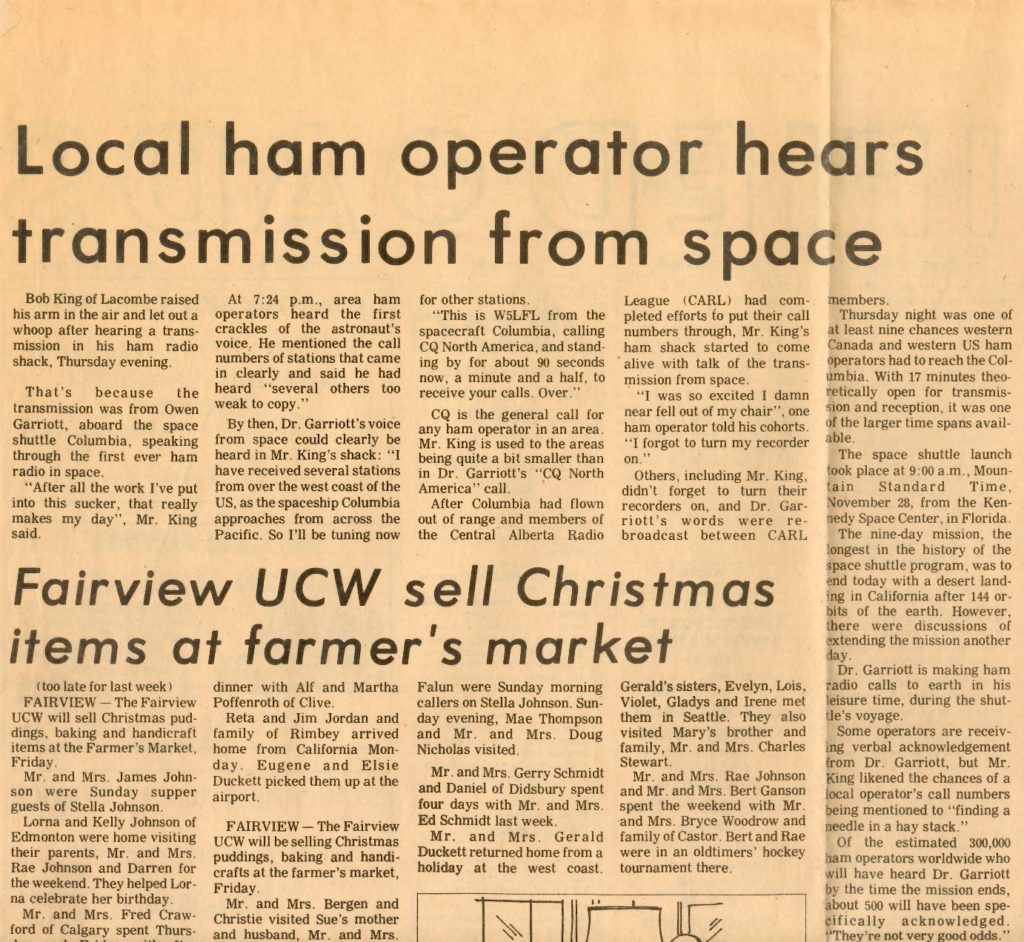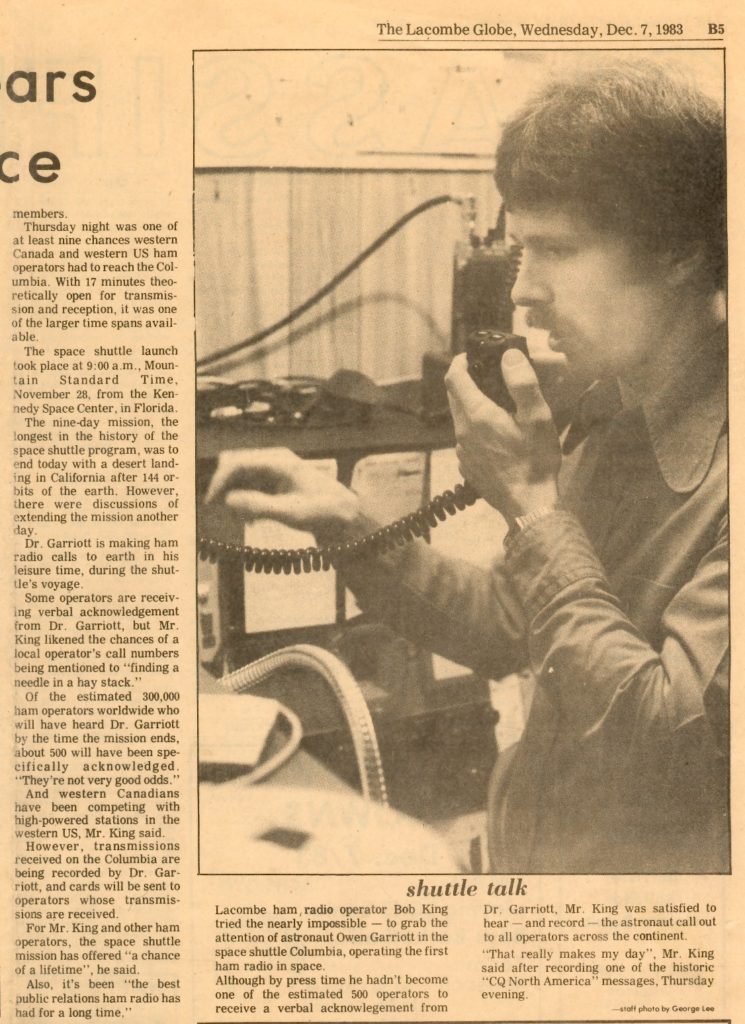- Home
- Registration
- Site Tools
- Articles
- Swap n Shop
- Contesting
- Grounding information for everyone
- History of the Central Alberta Amateur Radio Club
- CAARC owned Repeaters
- Club Repeater Info
- GMT Time Conversion Table
- VE/VA6 Incoming QSL Bureau
- Pine Lake Tornado Friday July 14, 2000.
- Amateur Radio to the Rescue
- CANWARN
- HAM Nation with Bob Heil K9EID
- Net info
- Events.
- ARES
- Links and On line study course.
- Field Day 2019
- Members D/L
- Forum/Swap and Shop
Education
CAARC sponsored classes to obtain your Amateur Radio License

Astronaut Owen Garriott, W5LFL, SK
Apr 16th
Amateur Radio in Space Pioneer Astronaut Owen Garriott, W5LFL, SK




04/15/2019
The US astronaut who pioneered the use of Amateur Radio to make contacts from space — Owen K. Garriott, W5LFL — died April 15 at his home in Huntsville, Alabama. He was 88. Garriott’s ham radio activity ushered in the formal establishment of Amateur Radio in space, first as SAREX — the Shuttle Amateur Radio Experiment, and later as ARISS — Amateur Radio on the International Space Station.
“Owen Garriott was a good friend and an incredible astronaut,†fellow astronaut Buzz Aldrin tweeted. “I have a great sadness as I learn of his passing today. Godspeed Owen.â€
An Oklahoma native, Garriott — an electrical engineer — spent 2 months aboard the Skylab space station in 1973 and 10 days aboard Spacelab-1 during a 1983 Space Shuttle Columbia mission. It was during the latter mission that Garriott thrilled radio amateurs around the world by making the first contacts from space. Thousands of hams listened on 2-meter FM, hoping to hear him or to make a contact. Garriott ended up working stations around the globe, among them such notables as the late King Hussein, JY1, of Jordan, and the late US Senator Barry Goldwater, K7UGA. He also made the first CW contact from space. Garriott called hamming from space “a pleasant pastime.â€
“I managed to do it in my off-duty hours, and it was a pleasure to get involved in it and to talk with people who are as interested in space as the 100,000 hams on the ground seemed to be,†he said in an interview published in the February 1984 edition of QST. “So, it was just a pleasant experience, the hamming in particular, all the way around.â€
Although Garriott had planned to operate on ham radio during his 10 days in space, no special provisions were made on board the spacecraft in terms of equipment — unlike the situation today on the International Space Station. Garriott simply used a hand-held transceiver with its antenna in the window of Spacelab-1. His first pass was down the US West Coast.
“[A]s I approached the US, I began to hear stations that were trying to reach me,†he told QST. “On my very first CQ, there were plenty of stations responding.†His first contact was with Lance Collister, WA1JXN, in Montana.
ARISS ARRL Representative Rosalie White, K1STO, met Garriott when he attended Hamvention, “both times, sitting next to him at Hamvention dinner banquets,†she recounted. “Once when he was a Special Achievement Award winner, and once with him and [his son] Richard when Richard won the 2009 Special Achievement Award. Owen was unassuming, very smart, kind, and up to date on the latest technology.†Garriott shared a Hamvention Special Achievement Award in 2002 with fellow Amateur Radio astronaut Tony England, W0ORE.
Richard Garriott, W5KWQ, was a private space traveler to the ISS, flown there by the Russian Federal Space Agency, and he also carried ham radio into space.
EMO worker tries to drum up enthusiasm for ham radio
Oct 14th
EMO worker tries to drum up enthusiasm for ham radio
In an emergency, ham radio is an essential form of communication, Mike Johnson says

A free workshop about ham radios will be held in Sackville on Oct. 22. (Nicole Williams/CBC)
A ham radio probably isn’t the first form of communication a person thinks about in an emergency, but sometimes, it’s the only one that works.
Ham radios can use wireless transmission to send messages to battery-operated radios.
And they can be useful when large storms knock out telecommunications, says Mike Johnson, the Cumberland Regional Emergency Management co-ordinator.
He is partnering up with EOS Eco-Energy and the West Cumb Amateur Radio Club to hold a free workshop in Sackville to try get more people interested in ham radios.
Different technology
Johnson, who is also a member of the WestCumb club in Amherst, N.S., said that when we lose essential communications such as cellphones, landlines and the Internet — a ham radio can come to the rescue. Hurricane Michael, which struck Florida this week, devastated normal channels of communications.
Storms that knock out telecommunications for long periods of time create more problems for co-ordinated emergency response, he said.
He said he’s already seen how ham radios could help in New Brunswick.
In January 2017, a massive ice storm knocked out power to thousands in the northeast for days.
Operators dwindling
“It became very difficult,” said Johnson.
Today, ham radios are considered a hobby more than a necessity, and not many people know how they work.
“Our numbers are dwindling,” Johnson said of the amateur radio clubs.
But younger members are needed, especially since the clubs’ services may be needed even more as the climate changes.
“We still use Morse code to this day,” he said.
Requires a test
Johnson said there are a few steps to becoming a ham radio operator.
“You need to study, take the test, once you pass it’s a one-time cost,” he said. “It’s good for life.”
After that, it’s just buying the equipment to use. Equipment for amateur radio costs between $300 and $5,000.
The workshop will be held at the Sackville Royal Canadian Legion on Monday, Oct. 22, at 6:30 p.m.
Amateur Tower Protocols
Sep 26th
A good one for the web. Its for Calgary but the laws are federal.
Rick
VE6RAK
This message for our members in Calgary, Forwarded from Wally:
Hello all,
I was asked to help find some info on what exactly the rules for towers were within the City of Calgary. I finally tracked down the brochure from the City regarding towers and it is attached.
Bottom line is they do not have direct authority over towers but encourage some protocols be observed (kind of a good neighbour policy). There is a City phone number to call if needed as well.
Basically, towers that do not exceed 15m, and with associated antennas that do not exceed 18.75m, do not require any consultation but Amateurs are encouraged to follow the notification guidelines in the document.
There may be restrictive caveats in some neighbourhoods though, and those should be listed in the property documents.
This would be a great document to have available to all hams via their respective club websites. If anyone sees that there are other clubs that are not represented in this email please forward a copy to them or send me their contact info and I can pass it along.
Thanks,
Dave VE6GAD
73 de VE6LK/AI7LK
..Vince
city-of-calgary-protocols-concerning-amateur-towers-1
Picnic prizes
Jun 20th
Congratulations to Brad VA6BMK, winner of the $500 raffle draw and Brian VE6CKC winner of the $200 raffle draw at the 46th Annual Red Deer Picnic June 19, 2016.
![20160620_113423[1]](https://caarc.ca/wp-caarc/wp-content/uploads/2016/06/20160620_1134231-300x225.jpg)
![20160620_113408[1]](https://caarc.ca/wp-caarc/wp-content/uploads/2016/06/20160620_1134081-1-300x225.jpg) Pictured here (right) John VA6SJA receives from Garry VE6CIA the Yaesu FTM 3200DR and the Celestron weather station draw prizes donated by Radio World Central which he won from the main draw and the Canwarn training draw.
Pictured here (right) John VA6SJA receives from Garry VE6CIA the Yaesu FTM 3200DR and the Celestron weather station draw prizes donated by Radio World Central which he won from the main draw and the Canwarn training draw.
Other prize winners include: Eric VE6HFF winner of an FTM 3100R donated by CAARC, Darren VA6WNG winner of an FTM 3100R donated by VE6HPY and VE6CIA, Rick VE6RAK winner of a Sangean Weather Alert Radio donated by Radio World Central, Pericles VA6PTA winner of the Raspberry PI2 donated by KoHen, and many others too numerous to mention.
Some of the ladies: Sheila (xyl of VE6HFF), Linda (xyl of VE6DE) and Brenda (xyl of VE6BLL) won the 2 beautiful hooked wall art and knitted blanket created and donated by Sylvia VE6SYL.
Special thanks go out to Greg VA6GMC and Karen VE6LDY for the super tasty pig and all the hard work that comes with preparing, cooking and presenting the wonderful pork that was on our plates. Also thanks to all the other donors of the wonderful food at the pot luck.
Chalk up another successful Ham Radio Pignic thanks to all of you that participated and made it all worth while.
Canwarn Training
Mar 24th
CANWARN, acronym for CANadian Weather Amateur Radio Network
Please note that CANWARN is not about storm chasing, it is about putting trained eyes at the local level to confirm what is happening under severe weather and communicating that information to the Meteorological Service of Canada.Here’s how CANWARN works in Central Alberta. When the regional weather forecast office (for the prairies this is the Prairie Storm Prediction Centre in Winnipeg, MB) would like to get ground observations of potentially severe thunderstorms they telephone the CANWARN person whom they have listed as the call-out person for the area of interest. In Central Alberta this will be the same people that are listed as ARES emergency coordinators. All Central Alberta and Olds ARES EC’s are trained CANWARN network controllers. The mechanics of how the net operates, local hams are notified and how their weather reports are forwarded to the forecast office are up to the CANWARN net controller. CANWARN Net Control may relay the observations or may elect to use a phone  to put the forecasters and amateur observer in direct contact.Typically, the person contacted by the Meteorological Service of Canada notifies the affected-area CANWARN hams who then radio their weather reports to their CANWARN Net Control Net. Net control then forwards the weather observations to the weather forecast office on a dedicated 1-800 phone number. As the storm moves along, reports would hopefully still come in from either stationary or mobile spotters allowing weather forecasters to continually compare the Carvel and Strathmore Doppler radar to what is being observed at ground level (below the radar horizon) and adjust their weather forecasts, Watches and Warnings accordingly.
Work Online At Your Own Pace, Basic HAM Radio, Training Course
Mar 7th
Work Online At Your Own Pace, Basic Amateur Radio, Training Course.
Click here http://www.clares.ca/self/index.html
Spring 2014 Basic Amateur Radio Course/Ham Radio Course
Jan 24th
What: Instruction and Industry Canada authorized exam for obtaining a Basic Amateur Radio Operator Certificate
When: Saturday March 15 and Saturday March 22, 2014 09:00-16:30
Where: LDS Church 3002 47 Ave, Red Deer
How: Preregister by sending $10 to Garry Jacobs VE6CIA 45 Selkirk Blvd. Red Deer, AB T4N 0G4 before March 8.
Refundable up to March 8 if you can’t make it.
Seating is limited so register early to avoid disappointment.
Preclass information available: http://www.eham.net/newham/
http://strategis.ic.gc.ca/epic/internet/insmt-gst.nsf/en/h_sf06073e.html
http://www.ic.gc.ca/eic/site/smt-gst.nsf/eng/h_sf05378.html
https://www.rac.ca/en/amateur-radio/beginner-info/getting-started.php
Questions contact: Garry VE6CIA 403-343-1930 or ve6cia@ gmail.com (without the space)
Bob Heil, (video casts) with various co-hosts and guests, will cover the excitement and importance of ham radio
Nov 24th
Bob Heil, with various co-hosts and guests, will cover the excitement and importance of ham radio – from tossing an antenna wire in a tree allowing you to talk to the world, to the importance of ham radio operators in time of disasters.
Records live every Wednesday at 6:00pm PT/9:00pm ET.  Also see drop down menu under ARTICLES.
New Brochure for the Central Alberta Amateur Radio Club
May 18th
I have produced a new Brochure for the Central Alberta Amateur Radio Club.
To download a color printable PDF document of the Club Advertising brochure complete with hot links back
to the web site  click this link
or check the second Tab under Site Tools menu.
Bob VE6BLD. Webmaster

